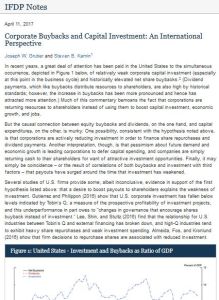Join getAbstract to access the summary!

Join getAbstract to access the summary!
Joseph W. Gruber and Steven B. Kamin
Corporate Buybacks and Capital Investment
An International Perspective
Federal Reserve Board, 2017
What's inside?
The relationship between corporate capital investment and returns to shareholders is tenuous.
Recommendation
Executives of many US public companies are paying their investors handsome returns in the form of share buybacks and dividend outlays, now at record high levels relative to GDP. At the same time, many firms have reduced their capital investment. This scenario is potentially worrisome for overall economic growth, particularly as it also manifests across a number of OECD nations. Economists Joseph W. Gruber and Steven B. Kamin assess the relationship, causality and correlation between returns to shareholders and corporate investment allocations, and come up with some intriguing conclusions. getAbstract recommends this expert report to executives and investors.
Summary
About the Authors
Joseph W. Gruber and Steven B. Kamin are economists with the Board of Governors of the Federal Reserve System.

















Comment on this summary